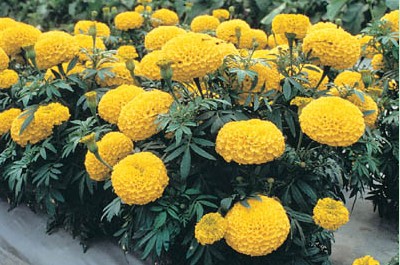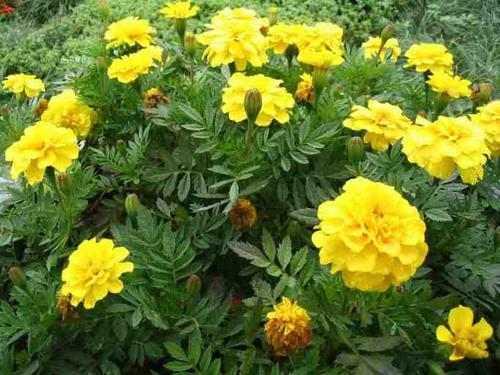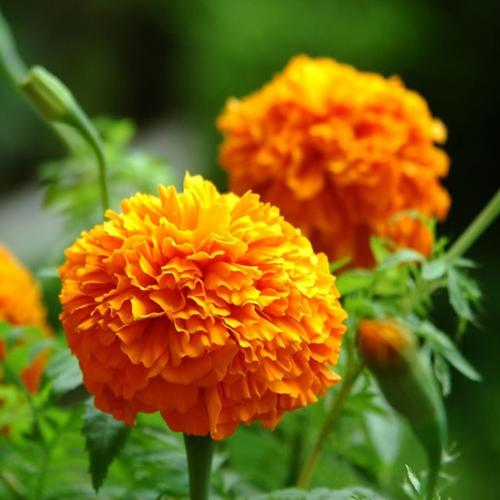How to Grow and Care for Marigold
Written by Maggie
Dec 13 2022

Marigold is a common flower plant, as a garden to appreciate flowers. Then how to grow and care for Marigold? In fact, Marigold is also very suitable for home yard plum maintenance, flowering is very good-looking. Let's learn together.
Marigold Picture

Marigold Info
| Botanical Name | Tagetes spp. |
| Common Names | Marigold |
| Plant Type | Annual flower |
| Sun | Full sun |
| Hardiness Zones | Annual in all zones |
| Flower color | Yellow, orange, white, red, gold, bicolor |
| Native Area | Mexico |
| Mature size | 4 to 36 inches tall and 6 to 18 inches wide |
How to Care for Marigold
Marigold Temperature Care
Marigold likes warm, sunny environments, not cold, drought tolerant, not suitable for cultivation in wet, hot environments. When we grow and care for marigold, the suitable growth temperature of Marigold is 15-25℃.
Marigold Soil Care
Marigold is not strict with the soil and prefers fertile, well-drained sandy loam.
Marigold Lighting Requirements
Marigold is a light-loving flower plant. Sufficient light is very beneficial to the growth of marigold. The plant is short and strong, and the color is gorgeous. When we grow and care for marigold, if the sun is not enough, the stems and leaves are soft and slender, and the flowers are few and small.
Marigold is sensitive to the duration of sunshine. Marigold will bloom Daisy-Like Flowers early when there is sufficient sunlight.
Marigold Watering
Marigold is moisture loving and drought tolerant. Generally in the rainy season in summer, excessive watering will lead to exuberant growth of the stem and leaves of marigold, affecting plant shape and flowering.
When we grow and care for marigolds, if in the summer high temperature period, flower friends must strictly control the amount of watering, it is recommended to dry a little better.
Marigold Fertilizer
Marigold is a fat-loving flower plant, also slightly tolerant of barren, generally rich and nutritious, marigold flowers, and the plant is also easy to grow tall. When we grow and care for marigold at the early growth stage of Marigold, the sparse liquid fertilizer was applied for 23 times in combination with topdressing.
After the flower buds appear, the potassium dihydrogen phosphate solution can be used for foliar spraying for 12 times, which is conducive to big flowers and bright colors. After flowering failure and pruning, mixed liquid fertilizer can be applied for 12 times to promote the growth of new shoots.
Marigold Care in Spring
The best time to sow marigold is in each spring. Marigold is planted in the spring and usually emerges about a week after sowing. When the seedlings have five to seven leaves and are about 10 centimeters in length, they can be transplanted or put into a pot.
When we grow and care for marigold, keep the soil moist, but not too much, keep it exposed to sunlight, and increase the circulation of air so that the marigold is well ventilated. During the growth of Marigold, the heart can be removed several times. To promote marigold germination of new branches, can be more flowering. (Read more about growing Marigold Companion Plants)

Marigold Care in Summer
Marigold likes warm, humid and sunny environments. When we grow and care for marigold in the hot weather with strong sunlight in summer, it should not be shaded too much, which will cause the plants to grow unfruitful and not flower enough.In summer, the temperature is high and the evaporation is large. Marigold has a large demand for water, so it should be watered frequently to keep the basin soil moist.
Summer is the main flowering period for marigold. When we grow and care for marigold, keeping the flowering temperature slightly lower can prolong the flowering period. After flower failure, cut off the remaining flower branches, strengthen water and fertilizer management, but also can bloom again.In summer, marigold can also be propagated from cuttings.
Marigold Care in Fall
Flowering of marigold can continue into the fall, but as the fall becomes cooler, flowering of marigold will decrease. When we grow and care for marigold, water and fertilizer should be reduced at this time. Move to the closed balcony with light, so that the flowering period is prolonged. The temperature will drop further in late autumn, and the growth of marigold will slow down when the temperature drops below 10℃. (Find more fall flowers here.)
Marigold Care in Winter
After the autumn flowers fade, as the temperature gradually drops, the marigold slowly starts to stop growing. When we grow and care for marigold in the cold winter, the temperature is below 5℃, and the marigold slowly Withers, waiting for the germination of the next spring.
Marigold Varieties
'Antigua' Series are African marigolds with strangely profuse blooms.
'Gem' Series are single-flowered signets with very fern-like foliage.
‘Naughty Marietta’ is a ruffled, deep-yellow French marigold with maroon splashes in the center.
Marigold Propagation
Marigolds are very handy to begin from seed. Their large, easy-to-handle seeds are regularly used with kids, for college projects. You can begin seeds indoors, about 6 to eight weeks earlier than your closing frost date, however it is no longer simply really worth it. Marigolds germinate rapidly exterior when direct sown, and on account that the plant life does not sincerely begin developing till the climate warms, the direct-sown flora have time to trap up to where the vegetation began indoors. Of course, you can discover seedlings in simply about each nursery, so you do not have to begin from seed at all if you truly choose to jump-start your flower garden.
Marigold Uses
Marigolds make satisfactory border plants, however their warm hues must be used with discretion. They work first-rate with both different warm colors, like yellow and orange daylilies, or with complementary purples, like salvia and verbena. Because they are quick plants, marigolds are typically used in the the front of a border or in containers.
French marigolds are reputed to have some pest-repelling traits and used to be viewed an precious flower for the vegetable garden, however there is now not a lot of proof that they without a doubt repel something without nematodes. Still, they add a lot of shade to the vegetable garden. You might also have some good fortune planting marigolds round the edges of my vegetable garden, to deter rabbits.

Read Next:
Top 10 Most Beautiful Roses in the World
Top 10 Most Beautiful Flowers in the World
26 Best Autumn Flowers to Plant for Fall Color in Garden
Top 30 Fall Flowers to Plant Beautiful Autumn Flowers
Latest Updated
- Benefits of Bugleweed - 7 Science-backed Health Benefits
- Bugleweed Dangers & Side Effects - Is It Poisonous?
- How to Plant Evergreen Trees - What You Should Know
- When to Plant Evergreens - Grow Guide for Evergreen Trees
- 12 Wonderful Evergreen Shrubs for Your Garden
- 12 Popular Evergreen Plants with Pictures for Beginners
- When And How To Prune A Lilac Bush Like a Pro
- How to Grow & Care for Lilac Vine (Hardenbergia Violacea)
- Japanese Lilac Tree (Syringa Reticulata) Care & Propagation Guide
- Shumard Oak Pros and Cons - What to Know
Popular Articles
- Winter maintenance of Antirrhinum Majus
- How to Grow Terminalia Mantaly Tree
- How to Grow and Care for Crossostephium Chinense
- How to grow Antirrhinum Majus in spring
- Peristeria Elata (Dove Orchid) Profile: Info & Care Guide
- Underwatered Snake Plant (Sansevieria Trifasciata) - Signs And How To Fix
- How to Care for Brazilian Jasmine Plant (Mandevilla Sanderi)
- How to Grow & Care for Graptopetalum Purple Delight in Summer
- Rosa Chinensis (China Rose): Plant Growing & Care Tips
- How to Care for Baby Sun Rose (Aptenia Cordifolia)